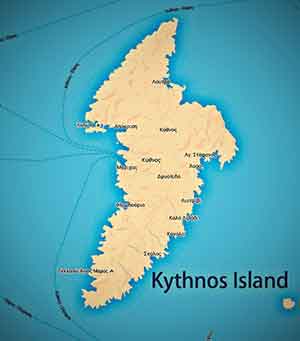Kythnos is one of the most beautiful islands of the Cyclades and in a close proximity to Athens. However, it remains a relatively unknown island for most, but those who have visited it can only be fascinated by its beauty and traditional settlements. Of course the island is dominated by the traditional Cycladic architecture which blends in harmony with the environment and stands out for its simplicity. At the same time the village of Dryopida surprises the visitor with its unique architecture that this rule.
Kythnos architecture
The worldwide and recognizable architecture of the Cyclades dominates the beautiful island of Kythnos. The dominant colors are white and blue while the houses are connected with each other with cobbled streets. The main purpose of the houses is to meet the daily needs of their residents but at the same time they have a defensive role as the island of Kythnos was significantly affected by the pirates during the Middle Ages. Thus the houses are built of stone with thick walls, which is a key element of the architecture of Kythnos, while the villages are built away from the sea to avoid pirate raids.
The white and blue color of the houses of Kythnos is due to Prime Minister Ioannis Metaxas who chose these colors for Cycladic houses in order to symbolize the white waves of the Aegean sea and the blue sky. Of course white has the ability to reduce solar absorption during the warm summer months.
The traditional houses in the Cyclades
The classic Cycladic house owes its apearence to a number of factors such as bright light, the lack of timber for the construction of large frames and the strong air. So the floor plan of the house is one -room, the houses are stone -built and they have very few windows and doors. Timber deficiency lead to the construction of intermediate arcs to support the roof. The interior is simple and often the altitude difference is what determines the operation of the space intended for a bedroom. The walls create niches that serve to place various objects such as a pitcher with water or cooking utensils.
Many times a second rectangle is added as a horizontal expansion or vertical if it is a two-storey house or building. Communication between the two floors is done with an outer stone staircase. The oven for cooking, the warehouse as well as the cistern are in the courtyard. As we said, the color was due to a 1936 law and initially the houses had the natural color of construction materials. In this way they tied harmoniously with the environment as they were built of materials on the island.
Pirates' raids have led to the fortification of the settlements and often the houses are built in concentric zones and at other times there is a daunting road network. The decorative elements of the traditional houses of Kythnos include embossed skylights, carvings and lintel.
The architecture of churches in Kythnos
The special architecture of the churches of Kythnos with the white walls and the Blue Tholos stand out and are a continuation of local culture so different from the large churches in mainland Greece. Churches are distinguished for its external strict geometric lines while the decoration is simple. Many of the churches have a flat roof while in others the Tholos is placed directly on the internal walls.
The agricultural terraces of Kythnos
One of the particularly architectural characteristics of the traditional architecture of Kythnos are the agricultural terraces. Their aim was to turn the wild slopes of the island into arable land so that people can make the most of the few arable lands that existed. The role of the agricultural terraces is double: they hold the soil from erosion while at the same time holding the scarce rain water. Everything was cultivated: wheat, barley, fruit and vegetables, figs, vines and almond trees. The agricultural terraces are essentially stone walls but this technique is also used for of a number of aauxiliary buildings such as storage buildings, stables or pigeon houses as well as fences that distinguish properties or define cobbled streets and trails.
Their construction is only made out of stones without any connective material in between, so a great deal of art was required for their construction and not collapsing. The slides follow the terrain of the ground by creating various technical difficulties in their construction.
The architecture of the Dryopida
The village of Dryopida differs from the rest of the island architecturally as it does not follow the traditional Cycladic architecture. The houses are two story with tiled roofs, which is probably due to the preoccupation of the inhabitants with the art of pottery. The village is invisible from the sea and is filled with small scattered squares, picturesque alleys and arches.
join.booking.com


























